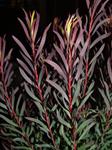
Leucadendron are indigenous to southern Africa. There are around 80 species. The genus includes evergreen shrubs and small trees which have green, often waxy, leaves which are arranged in spirals on the stem, dense flower inforescences, and woody conical seed pods. Leucadendrons are dioeceous plants. That is, they male and female plant parts are produced in separate flowers on separate plant species of all species in this genus. Male flowers occur as sessile heads (i.e. no stalk on flowers), on the growth tips. Female flowers are also on the growth tips but are cone-like with woody bracts. The fruit is a nut.
How do you propagate them?
These plants thrive in freely-draining soil. They should be planted in a raised bed if needs be. They also require bright light for at least six hours or more daily. Plants may be propagated by cuttings or seed. Seed-grown plants can take 3 years or more before they produce flowers. The seeds need warm days and cold nights to germinate. Plants of this genus are half-hardy, and are troubled by few serious pest or disease problems apart from root rot. Many cultivars are grown for their colourful foliage and for cut flowers. They may also be grown as a border plant, in a shrubbery, as a windbreak, or as a container plant.
Some species of Leucadendron
l. adscendens (syn. l. salignum) – can grow from 30cm to 2m depending on the cultivar, producing a multi-stemmed shrub. Leaves are narrowly lanceolate. They flower for a long period from late autumn through all of winter and spring. The flowers have colourful bracts surrounding the terminal flowers (colours vary from greens and yellows through to tones of orange and red). L. x Silvan Red is a popular cultivar derived from this species which was developed near Melbourne in Australia, and is a valuable cut flower there. Propagate from stem hardwood cuttings, treated with rooting hormone, and placed with 25°C bottom heat and intermittent misting.

If you want to find out more about Proteas, we have an
ebook and a
course on Proteas.